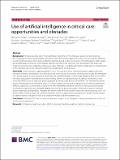Use of artificial intelligence in critical care: opportunities and obstacles
Author(s)
Pinsky, Michael R.; Bedoya, Armando; Bihorac, Azra; Celi, Leo; Churpek, Matthew; Economou-Zavlanos, Nicoleta J.; Elbers, Paul; Saria, Suchi; Liu, Vincent; Lyons, Patrick G.; Shickel, Benjamin; Toral, Patrick; Tscholl, David; Clermont, Gilles; ... Show more Show less
Download13054_2024_Article_4860.pdf (836.1Kb)
Publisher with Creative Commons License
Publisher with Creative Commons License
Creative Commons Attribution
Terms of use
Metadata
Show full item recordAbstract
Background
Perhaps nowhere else in the healthcare system than in the intensive care unit environment are the challenges to create useful models with direct time-critical clinical applications more relevant and the obstacles to achieving those goals more massive. Machine learning-based artificial intelligence (AI) techniques to define states and predict future events are commonplace activities of modern life. However, their penetration into acute care medicine has been slow, stuttering and uneven. Major obstacles to widespread effective application of AI approaches to the real-time care of the critically ill patient exist and need to be addressed.
Main body
Clinical decision support systems (CDSSs) in acute and critical care environments support clinicians, not replace them at the bedside. As will be discussed in this review, the reasons are many and include the immaturity of AI-based systems to have situational awareness, the fundamental bias in many large databases that do not reflect the target population of patient being treated making fairness an important issue to address and technical barriers to the timely access to valid data and its display in a fashion useful for clinical workflow. The inherent “black-box” nature of many predictive algorithms and CDSS makes trustworthiness and acceptance by the medical community difficult. Logistically, collating and curating in real-time multidimensional data streams of various sources needed to inform the algorithms and ultimately display relevant clinical decisions support format that adapt to individual patient responses and signatures represent the efferent limb of these systems and is often ignored during initial validation efforts. Similarly, legal and commercial barriers to the access to many existing clinical databases limit studies to address fairness and generalizability of predictive models and management tools.
Conclusions
AI-based CDSS are evolving and are here to stay. It is our obligation to be good shepherds of their use and further development.
Date issued
2024-04-08Department
Harvard--MIT Program in Health Sciences and Technology. Laboratory for Computational PhysiologyJournal
Critical Care
Publisher
Springer Science and Business Media LLC
Citation
Pinsky, M.R., Bedoya, A., Bihorac, A. et al. Use of artificial intelligence in critical care: opportunities and obstacles. Crit Care 28, 113 (2024).
Version: Final published version
ISSN
1364-8535
Keywords
Critical Care and Intensive Care Medicine